Question
The diagram shows a sketch of the function f (x) = 4x3 − 9x2 − 12x + 3.
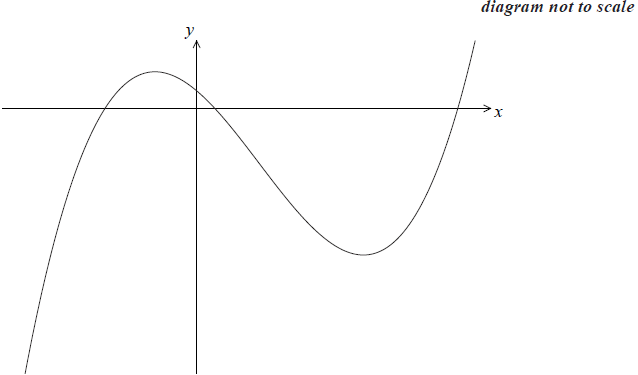
Write down the values of x where the graph of f (x) intersects the x-axis.[3]
Write down f ′(x).[3]
Find the value of the local maximum of y = f (x).[4]
Let P be the point where the graph of f (x) intersects the y axis.
Write down the coordinates of P.[1]
Let P be the point where the graph of f (x) intersects the y axis.
Find the gradient of the curve at P.[2]
The line, L, is the tangent to the graph of f (x) at P.
Find the equation of L in the form y = mx + c.[2]
There is a second point, Q, on the curve at which the tangent to f (x) is parallel to L.
Write down the gradient of the tangent at Q.[1]
There is a second point, Q, on the curve at which the tangent to f (x) is parallel to L.
Calculate the x-coordinate of Q.[3]
Answer/Explanation
Markscheme
–1.10, 0.218, 3.13 (A1)(A1)(A1)[3 marks]
f ′(x) = 12x2 – 18x – 12 (A1)(A1)(A1)
Note: Award (A1) for each correct term and award maximum of (A1)(A1) if other terms seen.[3 marks]
f ′(x) = 0 (M1)
x = –0.5, 2
x = –0.5 (A1)
Note: If x = –0.5 not stated, can be inferred from working below.
y = 4(–0.5)3 – 9(–0.5)2 – 12(–0.5) + 3 (M1)
y = 6.25 (A1)(G3)
Note: Award (M1) for their value of x substituted into f (x).
Award (M1)(G2) if sketch shown as method. If coordinate pair given then award (M1)(A1)(M1)(A0). If coordinate pair given with no working award (G2).[4 marks]
(0, 3) (A1)
Note: Accept x = 0, y = 3.[1 mark]
f ′(0) = –12 (M1)(A1)(ft)(G2)
Note: Award (M1) for substituting x = 0 into their derivative.[2 marks]
Tangent: y = –12x + 3 (A1)(ft)(A1)(G2)
Note: Award (A1)(ft) for their gradient, (A1) for intercept = 3.
Award (A1)(A0) if y = not seen.[2 marks]
–12 (A1)(ft)
Note: Follow through from their part (e).[1 mark]
12x2 – 18x – 12 = –12 (M1)
12x2 – 18x = 0 (M1)
x = 1.5, 0
At Q x = 1.5 (A1)(ft)(G2)
Note: Award (M1)(G2) for 12x2 – 18x – 12 = –12 followed by x = 1.5.
Follow through from their part (g).[3 marks]
Question
Consider the function \(f(x) = {x^3} + \frac{{48}}{x}{\text{, }}x \ne 0\).
Calculate \(f(2)\) .[2]
Sketch the graph of the function \(y = f(x)\) for \( – 5 \leqslant x \leqslant 5\) and \( – 200 \leqslant y \leqslant 200\) .[4]
Find \(f'(x)\) .[3]
Find \(f'(2)\) .[2]
Write down the coordinates of the local maximum point on the graph of \(f\) .[2]
Find the gradient of the tangent to the graph of \(f\) at \(x = 1\).[2]
There is a second point on the graph of \(f\) at which the tangent is parallel to the tangent at \(x = 1\).
Find the \(x\)-coordinate of this point.[2]
Answer/Explanation
Markscheme
\(f(2) = {2^3} + \frac{{48}}{2}\) (M1)
\(= 32\) (A1)(G2)[2 marks]
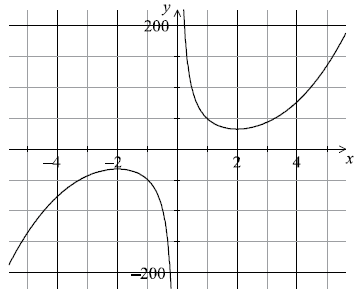
(A1) for labels and some indication of scale in an appropriate window
(A1) for correct shape of the two unconnected and smooth branches
(A1) for maximum and minimum in approximately correct positions
(A1) for asymptotic behaviour at \(y\)-axis (A4)
Notes: Please be rigorous.
The axes need not be drawn with a ruler.
The branches must be smooth: a single continuous line that does not deviate from its proper direction.
The position of the maximum and minimum points must be symmetrical about the origin.
The \(y\)-axis must be an asymptote for both branches. Neither branch should touch the axis nor must the curve approach the
asymptote then deviate away later.[4 marks]
\(f'(x) = 3{x^2} – \frac{{48}}{{{x^2}}}\) (A1)(A1)(A1)
Notes: Award (A1) for \(3{x^2}\) , (A1) for \( – 48\) , (A1) for \({x^{ – 2}}\) . Award a maximum of (A1)(A1)(A0) if extra terms seen.[3 marks]
\(f'(2) = 3{(2)^2} – \frac{{48}}{{{{(2)}^2}}}\) (M1)
Note: Award (M1) for substitution of \(x = 2\) into their derivative.
\(= 0\) (A1)(ft)(G1)[2 marks]
\(( – 2{\text{, }} – 32)\) or \(x = – 2\), \(y = – 32\) (G1)(G1)
Notes: Award (G0)(G0) for \(x = – 32\), \(y = – 2\) . Award at most (G0)(G1) if parentheses are omitted.[2 marks]
\(\{ y \geqslant 32\} \cup \{ y \leqslant – 32\} \) (A1)(A1)(ft)(A1)(ft)
Notes: Award (A1)(ft) \(y \geqslant 32\) or \(y > 32\) seen, (A1)(ft) for \(y \leqslant – 32\) or \(y < – 32\) , (A1) for weak (non-strict) inequalities used in both of the above.
Accept use of \(f\) in place of \(y\). Accept alternative interval notation.
Follow through from their (a) and (e).
If domain is given award (A0)(A0)(A0).
Award (A0)(A1)(ft)(A1)(ft) for \([ – 200{\text{, }} – 32]\) , \([32{\text{, }}200]\).
Award (A0)(A1)(ft)(A1)(ft) for \(] – 200{\text{, }} – 32]\) , \([32{\text{, }}200[\).[3 marks]
\(f'(1) = – 45\) (M1)(A1)(ft)(G2)
Notes: Award (M1) for \(f'(1)\) seen or substitution of \(x = 1\) into their derivative. Follow through from their derivative if working is seen.[2 marks]
\(x = – 1\) (M1)(A1)(ft)(G2)
Notes: Award (M1) for equating their derivative to their \( – 45\) or for seeing parallel lines on their graph in the approximately correct position.[2 marks]
Question
The function \(f(x)\) is defined by \(f(x) = 1.5x + 4 + \frac{6}{x}{\text{, }}x \ne 0\) .
Write down the equation of the vertical asymptote.[2]
Find \(f'(x)\) .[3]
Find the gradient of the graph of the function at \(x = – 1\).[2]
Using your answer to part (c), decide whether the function \(f(x)\) is increasing or decreasing at \(x = – 1\). Justify your answer.[2]
Sketch the graph of \(f(x)\) for \( – 10 \leqslant x \leqslant 10\) and \( – 20 \leqslant y \leqslant 20\) .[4]
\({{\text{P}}_1}\) is the local maximum point and \({{\text{P}}_2}\) is the local minimum point on the graph of \(f(x)\) .
Using your graphic display calculator, write down the coordinates of
(i) \({{\text{P}}_1}\) ;
(ii) \({{\text{P}}_2}\) .[4]
Using your sketch from (e), determine the range of the function \(f(x)\) for \( – 10 \leqslant x \leqslant 10\) .[3]
Answer/Explanation
Markscheme
\(x = 0\) (A1)(A1)
Note: Award (A1) for \(x = {\text{constant}}\), (A1) for \(0\).[2 marks]
\(f'(x) = 1.5 – \frac{6}{{{x^2}}}\) (A1)(A1)(A1)
Notes: Award (A1) for \(1.5\), (A1) for \( – 6\), (A1) for \({x^{ – 2}}\) . Award (A1)(A1)(A0) at most if any other term present.[3 marks]
\(1.5 – \frac{6}{{( – 1)}}\) (M1)
\( = – 4.5\) (A1)(ft)(G2)
Note: Follow through from their derivative function.[2 marks]
Decreasing, the derivative (gradient or slope) is negative (at \(x = – 1\)) (A1)(R1)(ft)
Notes: Do not award (A1)(R0). Follow through from their answer to part (c).[2 marks]
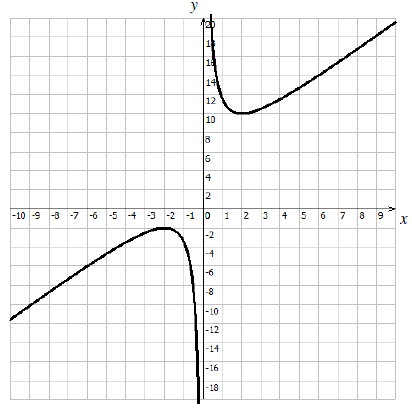 (A4)
(A4)
Notes: Award (A1) for labels and some indication of scales and an appropriate window.
Award (A1) for correct shape of the two unconnected, and smooth branches.
Award (A1) for the maximum and minimum points in the approximately correct positions.
Award (A1) for correct asymptotic behaviour at \(x = 0\) .
Notes: Please be rigorous.
The axes need not be drawn with a ruler.
The branches must be smooth and single continuous lines that do not deviate from their proper direction.
The max and min points must be symmetrical about point \((0{\text{, }}4)\) .
The \(y\)-axis must be an asymptote for both branches.[4 marks]
(i) \(( – 2{\text{, }} – 2)\) or \(x = – 2\), \(y = – 2\) (G1)(G1)
(ii) \((2{\text{, }}10)\) or \(x = 2\), \(y = 10\) (G1)(G1)[4 marks]
\(\{ – 2 \geqslant y\} \) or \(\{ y \geqslant 10\} \) (A1)(A1)(ft)(A1)
Notes: (A1)(ft) for \(y > 10\) or \(y \geqslant 10\) . (A1)(ft) for \(y < – 2\) or \(y \leqslant – 2\) . (A1) for weak (non-strict) inequalities used in both of the above. Follow through from their (e) and (f).[3 marks]
Question
Consider the function \(f(x) = – \frac{1}{3}{x^3} + \frac{5}{3}{x^2} – x – 3\).
Sketch the graph of y = f (x) for −3 ≤ x ≤ 6 and −10 ≤ y ≤ 10 showing clearly the axes intercepts and local maximum and minimum points. Use a scale of 2 cm to represent 1 unit on the x-axis, and a scale of 1 cm to represent 1 unit on the y-axis.[4]
Find the value of f (−1).[2]
Write down the coordinates of the y-intercept of the graph of f (x).[1]
Find f ‘(x).[3]
Show that \(f'( – 1) = – \frac{{16}}{3}\).[1]
Explain what f ‘(−1) represents.[2]
Find the equation of the tangent to the graph of f (x) at the point where x is –1.[2]
Sketch the tangent to the graph of f (x) at x = −1 on your diagram for (a).[2]
P and Q are points on the curve such that the tangents to the curve at these points are horizontal. The x-coordinate of P is a, and the x-coordinate of Q is b, b > a.
Write down the value of
(i) a ;
(ii) b .[2]
P and Q are points on the curve such that the tangents to the curve at these points are horizontal. The x-coordinate of P is a, and the x-coordinate of Q is b, b > a.
Describe the behaviour of f (x) for a < x < b.[1]
Answer/Explanation
Markscheme
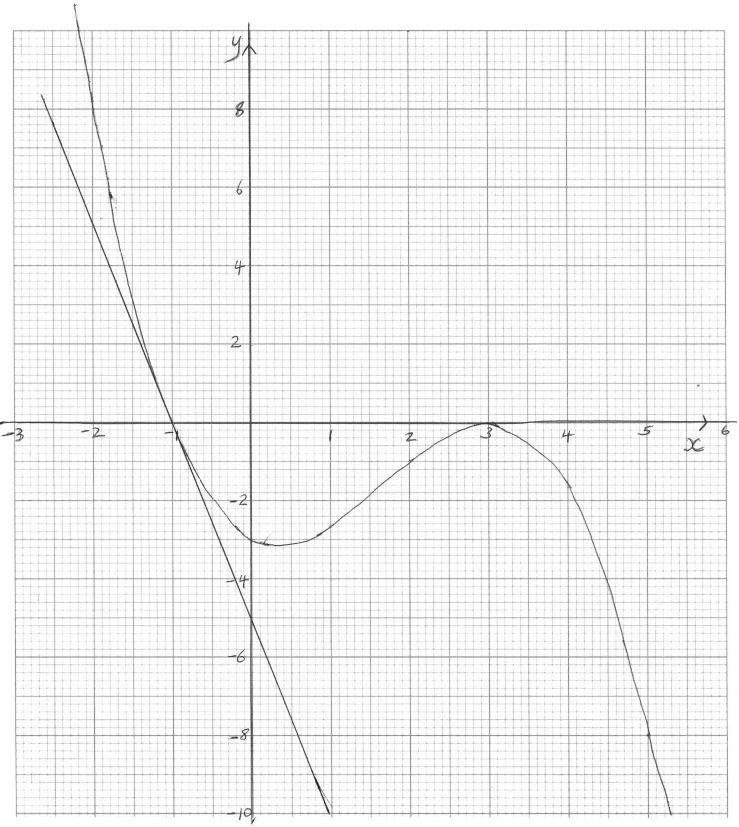
(A1) for indication of window and labels. (A1) for smooth curve that does not enter the first quadrant, the curve must consist of one line only.
(A1) for x and y intercepts in approximately correct positions (allow ±0.5).
(A1) for local maximum and minimum in approximately correct position. (minimum should be 0 ≤ x ≤ 1 and –2 ≤ y ≤ –4 ), the y-coordinate of the maximum should be 0 ± 0.5. (A4)[4 marks]
\(-\frac{1}{3}(-1)^3 + \frac{5}{3}(-1)^2 – (-1) – 3 \) (M1)
Note: Award (M1) for substitution of –1 into f (x)
= 0 (A1)(G2)[2 marks]
(0, –3) (A1)
OR
x = 0, y = –3 (A1)
Note: Award (A0) if brackets are omitted.[1 mark]
\(f'(x) = – {x^2} + \frac{{10}}{3}x – 1\) (A1)(A1)(A1)
Note: Award (A1) for each correct term. Award (A1)(A1)(A0) at most if there are extra terms.[3 marks]
\(f'( – 1) = – {( – 1)^2} + \frac{{10}}{3}( – 1) – 1\) (M1)
\(= -\frac{16}{3}\) (AG)
Note: Award (M1) for substitution of x = –1 into correct derivative only. The final answer must be seen.[1 mark]
f ‘(–1) gives the gradient of the tangent to the curve at the point with x = –1. (A1)(A1)
Note: Award (A1) for “gradient (of curve)”, (A1) for “at the point with x = –1”. Accept “the instantaneous rate of change of y” or “the (first) derivative”.[2 marks]
\(y = – \frac{16}{3} x + c\) (M1)
Note: Award (M1) for \(-\frac{16}{3}\) substituted in equation.
\(0 = – \frac{16}{3} \times (-1) + c \)
\(c = – \frac{16}{3}\)
\(y = – \frac{{16}}{3}x – \frac{{16}}{3}\) (A1)(G2)
Note: Accept y = –5.33x – 5.33.
OR
\((y – 0) = \frac{{-16}}{3}(x + 1)\) (M1)(A1)(G2)
Note: Award (M1) for \( – \frac{{16}}{3}\) substituted in equation, (A1) for correct equation. Follow through from their answer to part (b). Accept y = –5.33 (x +1). Accept equivalent equations.[2 marks]
(A1)(ft) for a tangent to their curve drawn.
(A1)(ft) for their tangent drawn at the point x = –1. (A1)(ft)(A1)(ft)
Note: Follow through from their graph. The tangent must be a straight line otherwise award at most (A0)(A1).[2 marks]
(i) \(a = \frac{1}{3}\) (G1)
(ii) \(b = 3\) (G1)
Note: If a and b are reversed award (A0)(A1).[2 marks]
f (x) is increasing (A1)[1 mark]
Question
Consider the function \(g(x) = bx – 3 + \frac{1}{{{x^2}}},{\text{ }}x \ne 0\).
Write down the equation of the vertical asymptote of the graph of y = g(x) .[2]
Write down g′(x) .[3]
The line T is the tangent to the graph of y = g(x) at the point where x = 1. The gradient of T is 3.
Show that b = 5.[2]
The line T is the tangent to the graph of y = g(x) at the point where x = 1. The gradient of T is 3.
Find the equation of T.[3]
Using your graphic display calculator find the coordinates of the point where the graph of y = g(x) intersects the x-axis.[2]
(i) Sketch the graph of y = g(x) for −2 ≤ x ≤ 5 and −15 ≤ y ≤ 25, indicating clearly your answer to part (e).
(ii) Draw the line T on your sketch.[6]
Using your graphic display calculator find the coordinates of the local minimum point of y = g(x) .[2]
Write down the interval for which g(x) is increasing in the domain 0 < x < 5 .[2]
Answer/Explanation
Markscheme
x = 0 (A1)(A1)
Notes: Award (A1) for x=constant, (A1) for 0. Award (A0)(A0) if answer is not an equation.[2 marks]
\(b – \frac{2}{{{x^3}}}\) (A1)(A1)(A1)
Note: Award (A1) for b, (A1) for −2, (A1) for \(\frac{1}{{{x^3}}}\) (or x−3). Award at most (A1)(A1)(A0) if extra terms seen.[3 marks]
\(3 = b – \frac{2}{{{{(1)}^3}}}\) (M1)(M1)
Note: Award (M1) for substituting 1 into their gradient function, (M1) for equating their gradient function to 3.
b = 5 (AG)
Note: Award at most (M1)(A0) if final line is not seen or b does not equal 5.[2 marks]
g(1) = 3 or (1, 3) (seen or implied from the line below) (A1)
3 = 3 × 1 + c (M1)
Note: Award (M1) for correct substitution of their point (1, 3) and gradient 3 into equation y = mx + c. Follow through from their point of tangency.
y = 3x (A1)(ft)(G2)
OR
y − 3 = 3(x − 1) (M1)(A1)(ft)(G2)
Note: Award (M1) for substitution of gradient 3 and their point (1, 3) into y − y1 = m(x − x1), (A1)(ft) for correct substitutions. Follow through from their point of tangency. Award at most (A1)(M1)(A0)(ft) if further incorrect working seen.[3 marks]
(−0.439, 0) ((−0.438785…, 0)) (G1)(G1)
Notes: If no parentheses award at most (G1)(G0). Accept x = 0.439, y = 0.[2 marks]
(i)
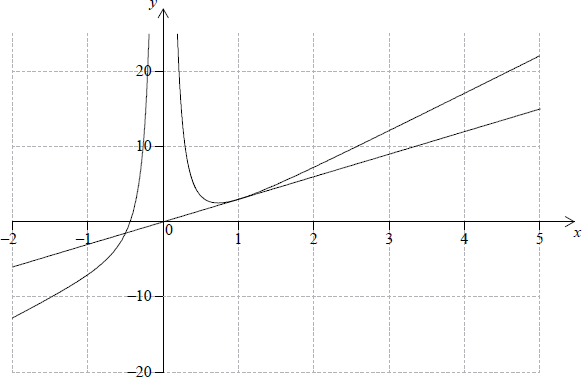
Award (A1) for labels and some indication of scale in the stated window.
Award (A1) for correct general shape (curve must be smooth and must not cross the y-axis)
Award (A1)(ft) for x-intercept consistent with their part (e).
Award (A1) for local minimum in the first quadrant. (A1)(A1)(A1)(ft)(A1)
(ii) Tangent to curve drawn at approximately x = 1 (A1)(A1)
Note: Award (A1) for a line tangent to curve approximately at x = 1. Must be a straight line for the mark to be awarded. Award (A1)(ft) for line passing through the origin. Follow through from their answer to part (d).[6 marks]
(0.737, 2.53) ((0.736806…, 2.52604…)) (G1)(G1)
Notes: Do not penalize for lack of parentheses if already penalized in (e). Accept x = 0.737, y = 2.53.[2 marks]
0.737 < x < 5 OR (0.737;5) (A1)(A1)(ft)
Notes: Award (A1) for correct strict or weak inequalities with x seen if the interval is given as inequalities, (A1)(ft) for 0.737 and 5 or their value from part (g).[2 marks]
Question
The graph of the function \(f(x) = \frac{{14}}{x} + x – 6\), for 1 ≤ x ≤ 7 is given below.
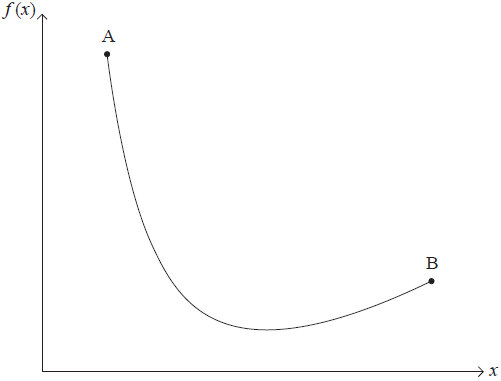
Calculate \(f (1)\).[2]
Find \(f ′(x)\).[3]
Use your answer to part (b) to show that the x-coordinate of the local minimum point of the graph of \(f\) is 3.7 correct to 2 significant figures.[3]
Find the range of \(f\).[3]
Points A and B lie on the graph of \(f\). The x-coordinates of A and B are 1 and 7 respectively.
Write down the y-coordinate of B.[1]
Points A and B lie on the graph of f . The x-coordinates of A and B are 1 and 7 respectively.
Find the gradient of the straight line passing through A and B.[2]
M is the midpoint of the line segment AB.
Write down the coordinates of M.[2]
L is the tangent to the graph of the function \(y = f (x)\), at the point on the graph with the same x-coordinate as M.
Find the gradient of L.[2]
Find the equation of L. Give your answer in the form \(y = mx + c\).[3]
Answer/Explanation
Markscheme
\(\frac{{14}}{{(1)}} + (1) – 6\) (M1)
Note: Award (M1) for substituting \(x = 1\) into \(f\).
\(= 9\) (A1)(G2)
\( – \frac{{14}}{{{x^2}}} + 1\) (A3)
Note: Award (A1) for \(-14\), (A1) for \(\frac{{14}}{{{x^2}}}\) or for \(x^{-2}\), (A1) for \(1\).
Award at most (A2) if any extra terms are present.
\( – \frac{{14}}{{{x^2}}} + 1 = 0\) or \(f ‘ (x) = 0 \) (M1)
Note: Award (M1) for equating their derivative in part (b) to 0.
\(\frac{{14}}{{{x^2}}} = 1\) or \({x^2} = 14\) or equivalent (M1)
Note: Award (M1) for correct rearrangement of their equation.
\(x = 3.74165…(\sqrt {14})\) (A1)
\(x = 3.7\) (AG)
Notes: Both the unrounded and rounded answers must be seen to award the (A1). This is a “show that” question; appeals to their GDC are not accepted –award a maximum of (M1)(M0)(A0).
Specifically, \( – \frac{{14}}{{{x^2}}} + 1 = 0\) followed by \(x = 3.74165…, x = 3.7\) is awarded (M1)(M0)(A0).
\(1.48 \leqslant y \leqslant 9\) (A1)(A1)(ft)(A1)
Note: Accept alternative notations, for example [1.48,9]. (\(x = \sqrt{14}\) leads to answer 1.48331…)
Note: Award (A1) for 1.48331…seen, accept 1.48378… from using the given answer \(x = 3.7\), (A1)(ft) for their 9 from part (a) seen, (A1) for the correct notation for their interval (accept \( \leqslant y \leqslant \) or \( \leqslant f \leqslant \) ).
3 (A1)
Note: Do not accept a coordinate pair.
\(\frac{{3 – 9}}{{7 – 1}}\) (M1)
Note: Award (M1) for their correct substitution into the gradient formula.
\(= -1\) (A1)(ft)(G2)
Note: Follow through from their answers to parts (a) and (e).
(4, 6) (A1)(ft)(A1)
Note: Accept \(x = 4\), \(y = 6\). Award at most (A1)(A0) if parentheses not seen.
If coordinates reversed award (A0)(A1)(ft).
Follow through from their answers to parts (a) and (e).
\( – \frac{{14}}{{{4^2}}} + 1\) (M1)
Note: Award (M1) for substitution into their gradient function.
Follow through from their answers to parts (b) and (g).
\( = \frac{1}{8}(0.125)\) (A1)(ft)(G2)
\(y – 1.5 = \frac{1}{8}(x – 4)\) (M1)(ft)(M1)
Note: Award (M1) for substituting their (4, 1.5) in any straight line formula,
(M1) for substituting their gradient in any straight line formula.
\(y = \frac{x}{8} + 4\) (A1)(ft)(G2)
Note: The form of the line has been specified in the question.
Question
Consider the function \(f(x) = \frac{3}{4}{x^4} – {x^3} – 9{x^2} + 20\).
Find \(f( – 2)\).[2]
Find \(f'(x)\).[3]
The graph of the function \(f(x)\) has a local minimum at the point where \(x = – 2\).
Using your answer to part (b), show that there is a second local minimum at \(x = 3\).[5]
The graph of the function \(f(x)\) has a local minimum at the point where \(x = – 2\).
Sketch the graph of the function \(f(x)\) for \( – 5 \leqslant x \leqslant 5\) and \( – 40 \leqslant y \leqslant 50\). Indicate on your
sketch the coordinates of the \(y\)-intercept.[4]
The graph of the function \(f(x)\) has a local minimum at the point where \(x = – 2\).
Write down the coordinates of the local maximum.[2]
Let \(T\) be the tangent to the graph of the function \(f(x)\) at the point \((2, –12)\).
Find the gradient of \(T\).[2]
The line \(L\) passes through the point \((2, −12)\) and is perpendicular to \(T\).
\(L\) has equation \(x + by + c = 0\), where \(b\) and \(c \in \mathbb{Z}\).
Find
(i) the gradient of \(L\);
(ii) the value of \(b\) and the value of \(c\).[5]
Answer/Explanation
Markscheme
\(\frac{3}{4}{( – 2)^4} – {( – 2)^3} – 9{( – 2)^2} + 20\) (M1)
Note: Award (M1) for substituting \(x = – 2\) in the function.
\(= 4\) (A1)(G2)
Note: If the coordinates \(( – 2,{\text{ }}4)\) are given as the answer award, at most, (M1)(A0). If no working shown award (G1).
If \(x = – 2,{\text{ }}y = 4\) seen then award full marks.[2 marks]
\(3{x^3} – 3{x^2} – 18x\) (A1)(A1)(A1)
Note: Award (A1) for each correct term, award at most (A1)(A1)(A0) if extra terms seen.[3 marks]
\(f'(3) = 3 \times {(3)^3} – 3 \times {(3)^2} – 18 \times 3\) (M1)
Note: Award (M1) for substitution in their \(f'(x)\) of \(x = 3\).
\( = 0\) (A1)
OR
\(3{x^3} – 3{x^2} – 18x = 0\) (M1)
Note: Award (M1) for equating their \(f'(x)\) to zero.
\(x = 3\) (A1)
\(f'({x_1}) = 3 \times {({x_1})^3} – 3 \times {({x_1})^2} – 18 \times {x_1} < 0\) where \(0 < {x_1} < 3\) (M1)
Note: Award (M1) for substituting a value of \({x_1}\) in the range \(0 < {x_1} < 3\) into their \(f’\) and showing it is negative (decreasing).
\(f'({x_2}) = 3 \times {({x_2})^3} – 3 \times {({x_2})^2} – 18 \times {x_2} > 0\) where \({x_2} > 3\) (M1)
Note: Award (M1) for substituting a value of \({x_2}\) in the range \({x_2} > 3\) into their \(f’\) and showing it is positive (increasing).
OR
With or without a sketch:
Showing \(f({x_1}) > f(3)\) where \({x_1} < 3\) and \({x_1}\) is close to 3. (M1)
Showing \(f({x_2}) > f(3)\) where \({x_2} > 3\) and \({x_2}\) is close to 3. (M1)
Note: If a sketch of \(f(x)\) is drawn in this part of the question and \(x = 3\) is identified as a stationary point on the curve, then
(i) award, at most, (M1)(A1)(M1)(M0) if the stationary point has been found;
(ii) award, at most, (M0)(A0)(M1)(M0) if the stationary point has not been previously found.
Since the gradients go from negative (decreasing) through zero to positive (increasing) it is a local minimum (R1)(AG)
Note: Only award (R1) if the first two marks have been awarded ie \(f'(3)\) has been shown to be equal to \(0\).[5 marks]
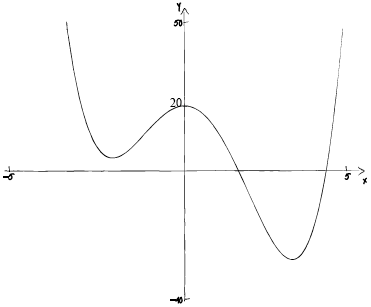 (A1)(A1)(A1)(A1)
(A1)(A1)(A1)(A1)
Notes: Award (A1) for labelled axes and indication of scale on both axes.
Award (A1) for smooth curve with correct shape.
Award (A1) for local minima in \({2^{{\text{nd}}}}\) and \({4^{{\text{th}}}}\) quadrants.
Award (A1) for y intercept \((0, 20)\) seen and labelled. Accept \(20\) on \(y\)–axis.
Do not award the third (A1) mark if there is a turning point on the \(x\)-axis.
If the derivative function is sketched then award, at most, (A1)(A0)(A0)(A0).
For a smooth curve (with correct shape) there should be ONE continuous thin line, no part of which is straight and no (one to many) mappings of \(x\).[4 marks]
\((0, 20)\) (G1)(G1)
Note: If parentheses are omitted award (G0)(G1).
OR
\(x = 0,{\text{ }}y = 20\) (G1)(G1)
Note: If the derivative function is sketched in part (d), award (G1)(ft)(G1)(ft) for \((–1.12, 12.2)\).[2 marks]
\(f'(2) = 3{(2)^3} – 3{(2)^2} – 18(2)\) (M1)
Notes: Award (M1) for substituting \(x = 2\) into their \(f'(x)\).
\( = – 24\) (A1)(ft)(G2)[2 marks]
(i) Gradient of perpendicular \( = \frac{1}{{24}}\) \((0.0417, 0.041666…)\) (A1)(ft)(G1)
Note: Follow through from part (f).
(ii) \(y + 12 = \frac{1}{{24}}(x – 2)\) (M1)(M1)
Note: Award (M1) for correct substitution of \((2, –12)\), (M1) for correct substitution of their perpendicular gradient into equation of line.
OR
\( – 12 = \frac{1}{{24}} \times 2 + d\) (M1)
\(d = – \frac{{145}}{{12}}\)
\(y = \frac{1}{{24}}x – \frac{{145}}{{12}}\) (M1)
Note: Award (M1) for correct substitution of \((2, –12)\) and gradient into equation of a straight line, (M1) for correct substitution of the perpendicular gradient and correct substitution of \(d\)into equation of line.
\(b = – 24,{\text{ }}c = – 290\) (A1)(ft)(A1)(ft)(G3)
Note: Follow through from parts (f) and g(i).
To award (ft) marks, \(b\) and \(c\) must be integers.
Where candidate has used \(0.042\) from g(i), award (A1)(ft) for \(–288\).[5 marks]
Question
Consider the function \(f(x) = \frac{{96}}{{{x^2}}} + kx\), where \(k\) is a constant and \(x \ne 0\).
Write down \(f'(x)\).[3]
The graph of \(y = f(x)\) has a local minimum point at \(x = 4\).
Show that \(k = 3\).[2]
The graph of \(y = f(x)\) has a local minimum point at \(x = 4\).
Find \(f(2)\).[2]
The graph of \(y = f(x)\) has a local minimum point at \(x = 4\).
Find \(f'(2)\)[2]
The graph of \(y = f(x)\) has a local minimum point at \(x = 4\).
Find the equation of the normal to the graph of \(y = f(x)\) at the point where \(x = 2\).
Give your answer in the form \(ax + by + d = 0\) where \(a,{\text{ }}b,{\text{ }}d \in \mathbb{Z}\).[3]
The graph of \(y = f(x)\) has a local minimum point at \(x = 4\).
Sketch the graph of \(y = f(x)\), for \( – 5 \leqslant x \leqslant 10\) and \( – 10 \leqslant y \leqslant 100\).[4]
The graph of \(y = f(x)\) has a local minimum point at \(x = 4\).
Write down the coordinates of the point where the graph of \(y = f(x)\) intersects the \(x\)-axis.[2]
The graph of \(y = f(x)\) has a local minimum point at \(x = 4\).
State the values of \(x\) for which \(f(x)\) is decreasing.[2]
Answer/Explanation
Markscheme
\(\frac{{ – 192}}{{{x^3}}} + k\) (A1)(A1)(A1)
Note: Award (A1) for \(-192\), (A1) for \({x^{ – 3}}\), (A1) for \(k\) (only).
at local minimum \(f'(x) = 0\) (M1)
Note: Award (M1) for seeing \(f'(x) = 0\) (may be implicit in their working).
\(\frac{{ – 192}}{{{4^3}}} + k = 0\) (A1)
\(k = 3\) (AG)
Note: Award (A1) for substituting \(x = 4\) in their \(f'(x) = 0\), provided it leads to \(k = 3\). The conclusion \(k = 3\) must be seen for the (A1) to be awarded.
\(\frac{{96}}{{{2^2}}} + 3(2)\) (M1)
Note: Award (M1) for substituting \(x = 2\) and \(k = 3\) in \(f(x)\).
\( = 30\) (A1)(G2)
\(\frac{{ – 192}}{{{2^3}}} + 3\) (M1)
Note: Award (M1) for substituting \(x = 2\) and \(k = 3\) in their \(f'(x)\).
\( = – 21\) (A1)(ft)(G2)
Note: Follow through from part (a).
\(y – 30 = \frac{1}{{21}}(x – 2)\) (A1)(ft)(M1)
Notes: Award (A1)(ft) for their \(\frac{1}{{21}}\) seen, (M1) for the correct substitution of their point and their normal gradient in equation of a line.
Follow through from part (c) and part (d).
OR
gradient of normal \( = \frac{1}{{21}}\) (A1)(ft)
\(30 = \frac{1}{{21}} \times 2 + c\) (M1)
\(c = 29\frac{{19}}{{21}}\)
\(y = \frac{1}{{21}}x + 29\frac{{19}}{{21}}\;\;\;(y = 0.0476x + 29.904)\)
\(x – 21y + 628 = 0\) (A1)(ft)(G2)
Notes: Accept equivalent answers.
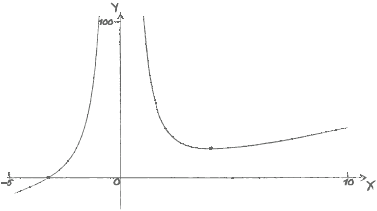 (A1)(A1)(A1)(A1)
(A1)(A1)(A1)(A1)
Notes: Award (A1) for correct window (at least one value, other than zero, labelled on each axis), the axes must also be labelled; (A1) for a smooth curve with the correct shape (graph should not touch \(y\)-axis and should not curve away from the \(y\)-axis), on the given domain; (A1) for axis intercept in approximately the correct position (nearer \(-5\) than zero); (A1) for local minimum in approximately the correct position (first quadrant, nearer the \(y\)-axis than \(x = 10\)).
If there is no scale, award a maximum of (A0)(A1)(A0)(A1) – the final (A1) being awarded for the zero and local minimum in approximately correct positions relative to each other.
\(( – 3.17,{\text{ }}0)\;\;\;\left( {( – 3.17480 \ldots ,{\text{ 0)}}} \right)\) (G1)(G1)
Notes: If parentheses are omitted award (G0)(G1)(ft).
Accept \(x = – 3.17,{\text{ }}y = 0\). Award (G1) for \(-3.17\) seen.
\(0 < x \leqslant 4{\text{ or }}0 < x < 4\) (A1)(A1)
Notes: Award (A1) for correct end points of interval, (A1) for correct notation (note: lower inequality must be strict).
Award a maximum of (A1)(A0) if \(y\) or \(f(x)\) used in place of \(x\).
Question
Consider the function \(f(x) = 0.5{x^2} – \frac{8}{x},{\text{ }}x \ne 0\).
Find \(f( – 2)\).[2]
Find \(f'(x)\).[3]
Find the gradient of the graph of \(f\) at \(x = – 2\).[2]
Let \(T\) be the tangent to the graph of \(f\) at \(x = – 2\).
Write down the equation of \(T\).[2]
Let \(T\) be the tangent to the graph of \(f\) at \(x = – 2\).
Sketch the graph of \(f\) for \( – 5 \leqslant x \leqslant 5\) and \( – 20 \leqslant y \leqslant 20\).[4]
Let \(T\) be the tangent to the graph of \(f\) at \(x = – 2\).
Draw \(T\) on your sketch.[2]
The tangent, \(T\), intersects the graph of \(f\) at a second point, P.
Use your graphic display calculator to find the coordinates of P.[2]
Answer/Explanation
Markscheme
\(0.5 \times {( – 2)^2} – \frac{8}{{ – 2}}\) (M1)
Note: Award (M1) for substitution of \(x = – 2\) into the formula of the function.
\(6\) (A1)(G2)
\(f'(x) = x + 8{x^{ – 2}}\) (A1)(A1)(A1)
Notes: Award (A1) for \(x\), (A1) for \(8\), (A1) for \({x^{ – 2}}\) or \(\frac{1}{{{x^2}}}\) (each term must have correct sign). Award at most (A1)(A1)(A0) if there are additional terms present or further incorrect simplifications are seen.
\(f'( – 2) = – 2 + 8{( – 2)^{ – 2}}\) (M1)
Note: Award (M1) for \(x = – 2\) substituted into their \(f'(x)\) from part (b).
\( = 0\) (A1)(ft)(G2)
Note: Follow through from their derivative function.
\(y = 6\;\;\;\)OR\(\;\;\;y = 0x + 6\;\;\;\)OR\(\;\;\;y – 6 = 0(x + 2)\) (A1)(ft)(A1)(ft)(G2)
Notes: Award (A1)(ft) for their gradient from part (c), (A1)(ft) for their answer from part (a). Answer must be an equation.
Award (A0)(A0) for \(x = 6\).
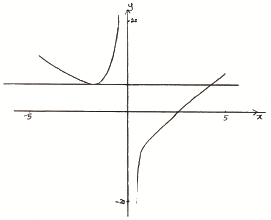 (A1)(A1)(A1)(A1)
(A1)(A1)(A1)(A1)
Notes: Award (A1) for labels and some indication of scales in the stated window. The point \((-2,{\text{ }}6)\) correctly labelled, or an \(x\)-value and a \(y\)-value on their axes in approximately the correct position, are acceptable indication of scales.
Award (A1) for correct general shape (curve must be smooth and must not cross the \(y\)-axis).
Award (A1) for \(x\)-intercept in approximately the correct position.
Award (A1) for local minimum in the second quadrant.
Tangent to graph drawn approximately at \(x = – 2\) (A1)(ft)(A1)(ft)
Notes: Award (A1)(ft) for straight line tangent to curve at approximately \(x = – 2\), with approximately correct gradient. Tangent must be straight for the (A1)(ft) to be awarded.
Award (A1)(ft) for (extended) line passing through approximately their \(y\)-intercept from (d). Follow through from their gradient in part (c) and their equation in part (d).
\((4,{\text{ }}6)\;\;\;\)OR\(\;\;\;x = 4,{\text{ }}y = 6\) (G1)(ft)(G1)(ft)
Notes: Follow through from their tangent from part (d). If brackets are missing then award (G0)(G1)(ft).
If line intersects their graph at more than one point (apart from \(( – 2,{\text{ }}6)\)), follow through from the first point of intersection (to the right of \( – 2\)).
Award (G0)(G0) for \(( – 2,{\text{ }}6)\).
Question
A distress flare is fired into the air from a ship at sea. The height, \(h\) , in metres, of the flare above sea level is modelled by the quadratic function
\[h\,(t) = – 0.2{t^2} + 16t + 12\,,\,t \geqslant 0\,,\]
where \(t\) is the time, in seconds, and \(t = 0\,\) at the moment the flare was fired.
Write down the height from which the flare was fired.[1]
Find the height of the flare \(15\) seconds after it was fired.[2]
The flare fell into the sea \(k\) seconds after it was fired.
Find the value of \(k\) .[2]
Find \(h’\,(t)\,.\)[2]
i) Show that the flare reached its maximum height \(40\) seconds after being fired.
ii) Calculate the maximum height reached by the flare.[3]
The nearest coastguard can see the flare when its height is more than \(40\) metres above sea level.
Determine the total length of time the flare can be seen by the coastguard.[3]
Answer/Explanation
Markscheme
\(12\,({\text{m}})\) (A1)
\((h\,(15) = ) – 0.2 \times {15^2} + 16 \times 15 + 12\) (M1)
Note: Award (M1) for substitution of \(15\) in expression for \(h\).
\( = 207\,({\text{m}})\) (A1)(G2)
\(h\,(k) = 0\) (M1)
Note: Award (M1) for setting \(h\) to zero.
\((k = )\,\,\,80.7\,({\text{s}})\,\,\,(80.7430)\) (A1)(G2)
Note: Award at most (M1)(A0) for an answer including \(K = – 0.743\) .
Award (A0) for an answer of \(80\) without working.
\(h’\,(t) = – 0.4t + 16\) (A1)(A1)
Note: Award (A1) for \( – 0.4t\), (A1) for \(16\). Award at most (A1)(A0) if extra terms seen. Do not accept \(x\) for \(t\).
i) \( – 0.4t + 16 = 0\) (M1)
Note: Award (M1) for setting their derivative, from part (d), to zero, provided the correct conclusion is stated and consistent with their \(h’\,(t)\).
OR
\(t = \frac{{ – 16}}{{2 \times ( – 0.2)}}\) (M1)
Note: Award (M1) for correct substitution into axis of symmetry formula, provided the correct conclusion is stated.
\(t = \,\,40\,({\text{s}})\) (AG)
ii) \( – 0.2 \times {40^2} + 16 \times 40 + 12\) (M1)
Note: Award (M1) for substitution of \(40\) in expression for \(h\).
\( = 332\,({\text{m}})\) (A1)(G2)
\(h\,(t) = 40\) (M1)
Note: Award (M1) for setting \(h\) to \(40\). Accept inequality sign.
OR
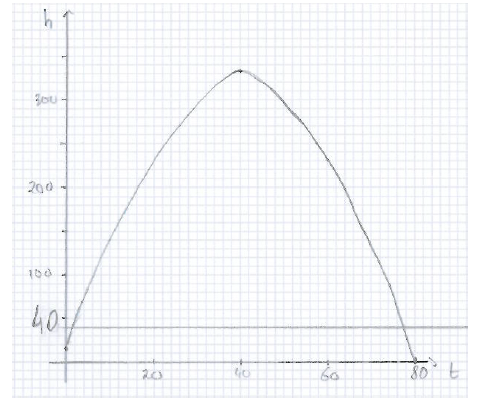
M1
Note: Award (M1) for correct sketch. Indication of scale is not required.
\(78.2 – 1.17\,\,(78.2099…\,\, – 1.79005…)\) (A1)
Note: Award (A1) for \(1.79\) and \(78.2\) seen.
(total time \( = \)) \(76.4\,({\text{s}})\,\,\,(76.4198…)\) (A1)(G2)
Note: Award (G1) if the two endpoints are given as the final answer with no working.
Question
The line \({L_1}\) has equation \(2y – x – 7 = 0\) and is shown on the diagram.
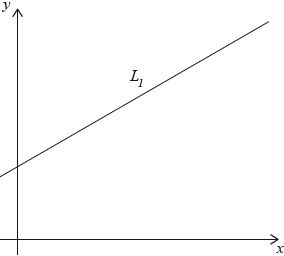
The point A has coordinates \((1,{\text{ }}4)\).
The point C has coordinates \((5,{\text{ }}12)\). M is the midpoint of AC.
The straight line, \({L_2}\), is perpendicular to AC and passes through M.
The point D is the intersection of \({L_1}\) and \({L_2}\).
The length of MD is \(\frac{{\sqrt {45} }}{2}\).
The point B is such that ABCD is a rhombus.
Show that A lies on \({L_1}\).[2]
Find the coordinates of M.[2]
Find the length of AC.[2]
Show that the equation of \({L_2}\) is \(2y + x – 19 = 0\).[5]
Find the coordinates of D.[2]
Write down the length of MD correct to five significant figures.[1]
Find the area of ABCD.[3]
Answer/Explanation
Markscheme
\(2 \times 4 – 1 – 7 = 0\) (or equivalent) (R1)
Note: For (R1) accept substitution of \(x = 1\) or \(y = 4\) into the equation followed by a confirmation that \(y = 4\) or \(x = 1\).
(since the point satisfies the equation of the line,) A lies on \({L_1}\) (A1)
Note: Do not award (A1)(R0).[2 marks]
\(\frac{{1 + 5}}{2}\) OR \(\frac{{4 + 12}}{2}\) seen (M1)
Note: Award (M1) for at least one correct substitution into the midpoint formula.
\((3,{\text{ }}8)\) (A1)(G2)
Notes: Accept \(x = 3,{\text{ }}y = 8\).
Award (M1)(A0) for \(\left( {\frac{{1 + 5}}{2},{\text{ }}\frac{{4 + 12}}{2}} \right)\).
Award (G1) for each correct coordinate seen without working.[2 marks]
\(\sqrt {{{(5 – 1)}^2} + {{(12 – 4)}^2}} \) (M1)
Note: Award (M1) for a correct substitution into distance between two points formula.
\( = 8.94{\text{ }}\left( {4\sqrt 5 ,{\text{ }}\sqrt {80} ,{\text{ }}8.94427 \ldots } \right)\) (A1)(G2)[2 marks]
gradient of \({\text{AC}} = \frac{{12 – 4}}{{5 – 1}}\) (M1)
Note: Award (M1) for correct substitution into gradient formula.
\( = 2\) (A1)
Note: Award (M1)(A1) for gradient of \({\text{AC}} = 2\) with or without working
gradient of the normal \( = – \frac{1}{2}\) (M1)
Note: Award (M1) for the negative reciprocal of their gradient of AC.
\(y – 8 = – \frac{1}{2}(x – 3)\) OR \(8 = – \frac{1}{2}(3) + c\) (M1)
Note: Award (M1) for substitution of their point and gradient into straight line formula. This (M1) can only be awarded where \( – \frac{1}{2}\) (gradient) is correctly determined as the gradient of the normal to AC.
\(2y – 16 = – (x – 3)\) OR \( – 2y + 16 = x – 3\) OR \(2y = – x + 19\) (A1)
Note: Award (A1) for correctly removing fractions, but only if their equation is equivalent to the given equation.
\(2y + x – 19 = 0\) (AG)
Note: The conclusion \(2y + x – 19 = 0\) must be seen for the (A1) to be awarded.
Where the candidate has shown the gradient of the normal to \({\text{AC}} = – 0.5\), award (M1) for \(2(8) + 3 – 19 = 0\) and (A1) for (therefore) \(2y + x – 19 = 0\).
Simply substituting \((3,{\text{ }}8)\) into the equation of \({L_2}\) with no other prior working, earns no marks.[5 marks]
\((6,{\text{ }}6.5)\) (A1)(A1)(G2)
Note: Award (A1) for 6, (A1) for 6.5. Award a maximum of (A1)(A0) if answers are not given as a coordinate pair. Accept \(x = 6,{\text{ }}y = 6.5\).
Award (M1)(A0) for an attempt to solve the two simultaneous equations \(2y – x – 7 = 0\) and \(2y + x – 19 = 0\) algebraically, leading to at least one incorrect or missing coordinate.[2 marks]
3.3541 (A1)
Note: Answer must be to 5 significant figures.[1 mark]
\(2 \times \frac{1}{2} \times \sqrt {80} \times \frac{{\sqrt {45} }}{2}\) (M1)(M1)
Notes: Award (M1) for correct substitution into area of triangle formula.
If their triangle is a quarter of the rhombus then award (M1) for multiplying their triangle by 4.
If their triangle is a half of the rhombus then award (M1) for multiplying their triangle by 2.
OR
\(\frac{1}{2} \times \sqrt {80} \times \sqrt {45} \) (M1)(M1)
Notes: Award (M1) for doubling MD to get the diagonal BD, (M1) for correct substitution into the area of a rhombus formula.
Award (M1)(M1) for \(\sqrt {80} \times \) their (f).
\( = 30\) (A1)(ft)(G3)
Notes: Follow through from parts (c) and (f).
\(8.94 \times 3.3541 = 29.9856 \ldots \)[3 marks]
Question
Consider the function \(f\left( x \right) = \frac{{48}}{x} + k{x^2} – 58\), where x > 0 and k is a constant.
The graph of the function passes through the point with coordinates (4 , 2).
P is the minimum point of the graph of f (x).
Find the value of k.[2]
Using your value of k , find f ′(x).[3]
Use your answer to part (b) to show that the minimum value of f(x) is −22 .[3]
Write down the two values of x which satisfy f (x) = 0.[2]
Sketch the graph of y = f (x) for 0 < x ≤ 6 and −30 ≤ y ≤ 60.
Clearly indicate the minimum point P and the x-intercepts on your graph.[4]
Answer/Explanation
Markscheme
\(\frac{{48}}{4} + k \times {4^2} – 58 = 2\) (M1)
Note: Award (M1) for correct substitution of x = 4 and y = 2 into the function.
k = 3 (A1) (G2)[2 marks]
\(\frac{{ – 48}}{{{x^2}}} + 6x\) (A1)(A1)(A1)(ft) (G3)
Note: Award (A1) for −48 , (A1) for x−2, (A1)(ft) for their 6x. Follow through from part (a). Award at most (A1)(A1)(A0) if additional terms are seen.[3 marks]
\(\frac{{ – 48}}{{{x^2}}} + 6x = 0\) (M1)
Note: Award (M1) for equating their part (b) to zero.
x = 2 (A1)(ft)
Note: Follow through from part (b). Award (M1)(A1) for \(\frac{{ – 48}}{{{{\left( 2 \right)}^2}}} + 6\left( 2 \right) = 0\) seen.
Award (M0)(A0) for x = 2 seen either from a graphical method or without working.
\(\frac{{48}}{2} + 3 \times {2^2} – 58\,\,\,\left( { = – 22} \right)\) (M1)
Note: Award (M1) for substituting their 2 into their function, but only if the final answer is −22. Substitution of the known result invalidates the process; award (M0)(A0)(M0).
−22 (AG)[3 marks]
0.861 (0.860548…), 3.90 (3.90307…) (A1)(ft)(A1)(ft) (G2)
Note: Follow through from part (a) but only if the answer is positive. Award at most (A1)(ft)(A0) if answers are given as coordinate pairs or if extra values are seen. The function f (x) only has two x-intercepts within the domain. Do not accept a negative x-intercept.[2 marks]
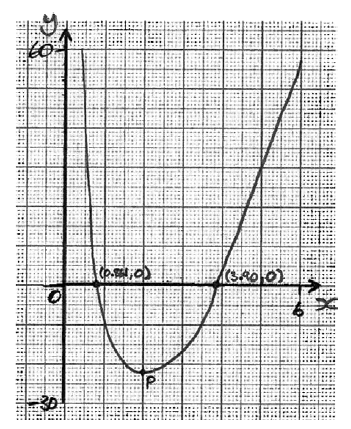 (A1)(A1)(ft)(A1)(ft)(A1)(ft)
(A1)(A1)(ft)(A1)(ft)(A1)(ft)
Note: Award (A1) for correct window. Axes must be labelled.
(A1)(ft) for a smooth curve with correct shape and zeros in approximately correct positions relative to each other.
(A1)(ft) for point P indicated in approximately the correct position. Follow through from their x-coordinate in part (c). (A1)(ft) for two x-intercepts identified on the graph and curve reflecting asymptotic properties.[4 marks]
Question
Consider the curve y = 2x3 − 9x2 + 12x + 2, for −1 < x < 3
Sketch the curve for −1 < x < 3 and −2 < y < 12.[4]
A teacher asks her students to make some observations about the curve.
Three students responded.
Nadia said “The x-intercept of the curve is between −1 and zero”.
Rick said “The curve is decreasing when x < 1 ”.
Paula said “The gradient of the curve is less than zero between x = 1 and x = 2 ”.
State the name of the student who made an incorrect observation.[1]
Find the value of y when x = 1 .[2]
Find \(\frac{{{\text{dy}}}}{{{\text{dx}}}}\).[3]
Show that the stationary points of the curve are at x = 1 and x = 2.[2]
Given that y = 2x3 − 9x2 + 12x + 2 = k has three solutions, find the possible values of k.[3]
Answer/Explanation
Markscheme
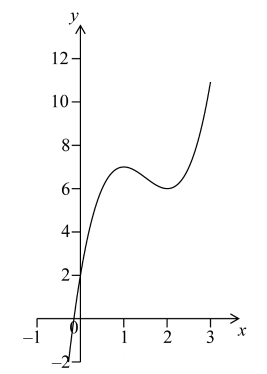 (A1)(A1)(A1)(A1)
(A1)(A1)(A1)(A1)
Note: Award (A1) for correct window (condone a window which is slightly off) and axes labels. An indication of window is necessary. −1 to 3 on the x-axis and −2 to 12 on the y-axis and a graph in that window.
(A1) for correct shape (curve having cubic shape and must be smooth).
(A1) for both stationary points in the 1st quadrant with approximate correct position,
(A1) for intercepts (negative x-intercept and positive y intercept) with approximate correct position.[4 marks]
Rick (A1)
Note: Award (A0) if extra names stated.[1 mark]
2(1)3 − 9(1)2 + 12(1) + 2 (M1)
Note: Award (M1) for correct substitution into equation.
= 7 (A1)(G2)[2 marks]
6x2 − 18x + 12 (A1)(A1)(A1)
Note: Award (A1) for each correct term. Award at most (A1)(A1)(A0) if extra terms seen.[3 marks]
6x2 − 18x + 12 = 0 (M1)
Note: Award (M1) for equating their derivative to 0. If the derivative is not explicitly equated to 0, but a subsequent solving of their correct equation is seen, award (M1).
6(x − 1)(x − 2) = 0 (or equivalent) (M1)
Note: Award (M1) for correct factorization. The final (M1) is awarded only if answers are clearly stated.
Award (M0)(M0) for substitution of 1 and of 2 in their derivative.x = 1, x = 2 (AG)
[2 marks]
6 < k < 7 (A1)(A1)(ft)(A1)
Note: Award (A1) for an inequality with 6, award (A1)(ft) for an inequality with 7 from their part (c) provided it is greater than 6, (A1) for their correct strict inequalities. Accept ]6, 7[ or (6, 7).[3 marks]
Question
A deep sea diver notices that the intensity of light, \(I\) , below the surface of the ocean decreases with depth, \(d\) , according to the formula
\[I = k{(1.05)^{ – d}}{\text{,}}\]where \(I\) is expressed as a percentage, \(d\) is the depth in metres below the surface and \(k\) is a constant.
The intensity of light at the surface is \(100\% \).
Calculate the value of \(k\) .[2]
Find the intensity of light at a depth \(25{\text{ m}}\) below the surface.[2]
To be able to see clearly, a diver needs the intensity of light to be at least \(65\% \).
Using your graphic display calculator, find the greatest depth below the surface at which she can see clearly.[2]
The table below gives the intensity of light (correct to the nearest integer) at different depths.

Using this information draw the graph of \(I\) against \(d\) for \(0 \leqslant d \leqslant 100\) . Use a scale of \(1{\text{ cm}}\) to represent 10 metres on the horizontal axis and 1 cm to represent \(10\% \) on the vertical axis.[4]
Some sea creatures have adapted so they can see in low intensity light and cannot tolerate too much light.
Indicate clearly on your graph the range of depths sea creatures could inhabit if they can tolerate between \(5\% \) and \(35\% \) of the light intensity at the surface.[2]
Answer/Explanation
Markscheme
\(d = 0\), \(k = 100\) (M1)(A1)(G2)
Note: Award (M1) for \(d = 0\) seen.
\(I = 100 \times {(1.05)^{ – 25}} = 29.5(\% )\) (\(29.5302 \ldots \)) (M1)(A1)(ft)(G2)
\(65 = 100 \times {(1.05)^{ – d}}\) (M1)
Note: Award (M1) for sketch with line drawn at \(y = 65\) .
\(d = 8.83{\text{ (m)}}\) (\(8.82929 \ldots \)) (A1)(ft)(G2)
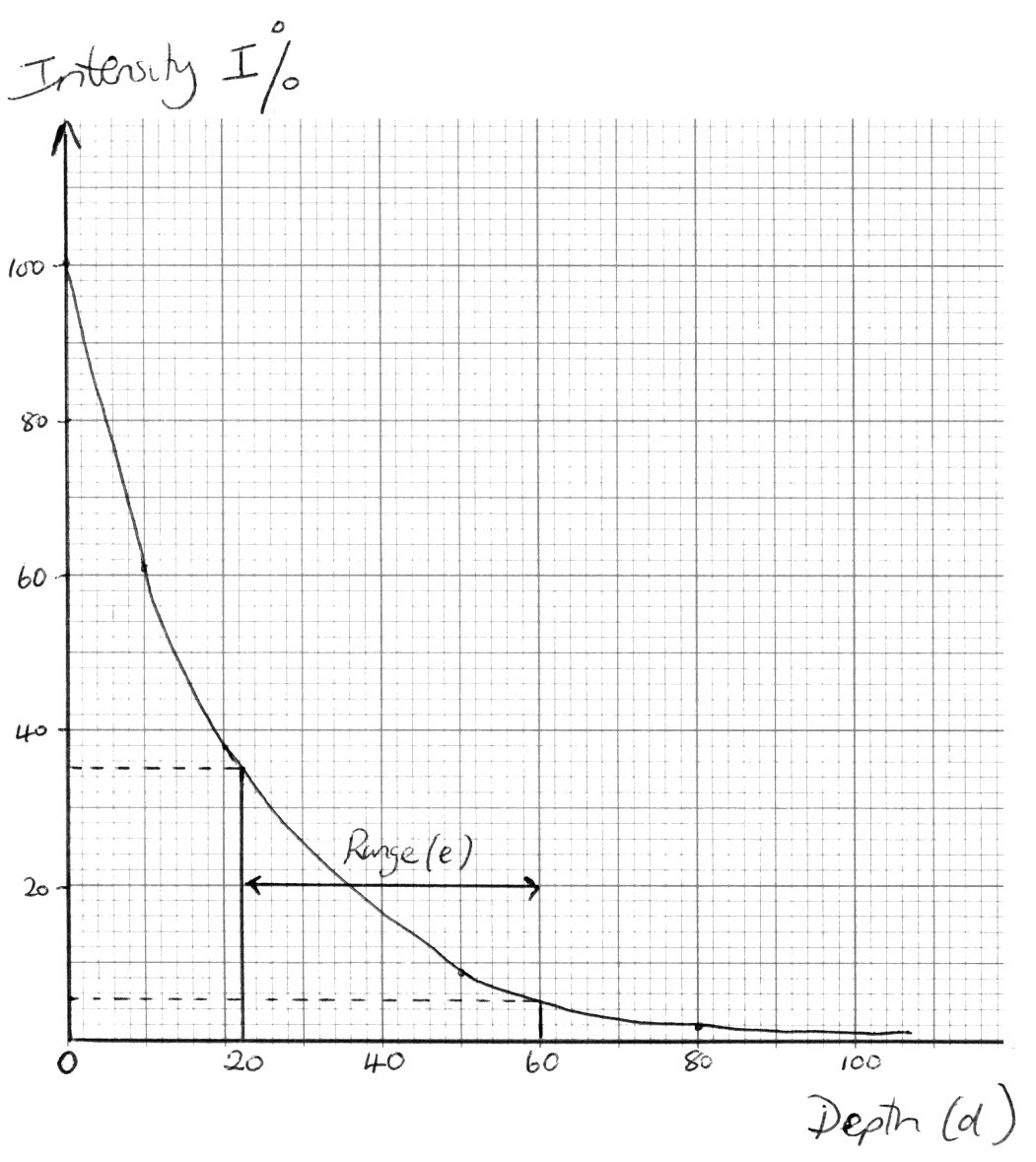
(A1) for labels and scales
(A2) for all points correct, (A1) for 3 or 4 points correct
(A1) for smooth curve asymptotic to the \(x\)-axis (A4)
Lines in approx correct positions on graph (M1)
The range of values indicated (arrows or shading) \(22\)–\(60{\text{ m}}\) (A1)
